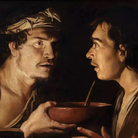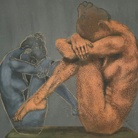Futuruins

Dal 19 December 2018 al 24 March 2019
Venezia
Luogo: Palazzo Fortuny
Indirizzo: San Marco 3958
Orari: Mer - Lun 10 - 18 | Biglietteria 10 - 17 | Mar chiuso
Curatori: Daniela Ferretti, Dimitri Ozerkov, con Dario Dalla Lana
Enti promotori:
- Museo Statale Ermitage - San Pietroburgo in collaborazione con Ermitage Italia
Costo del biglietto: Intero 10 € | Ridotto 8 € | Gratuito Bambini dai 0 ai 5 anni Diversamente abili con accompagnatore Guide turistiche abilitate che accompagnino gruppi o visitatori individuali; per ogni gruppo di almeno 15 persone, 1 ingresso gratuito (solo con prenotazione) Docenti accompagnatori di gruppi scolastici, fino ad un massimo di 2 per gruppo Accompagnatori (max. 1) di gruppi di adulti partner ordinari MUVE Possessori Art pass Fondazione Venetian Heritage Possessori Art Pass Venice Foundation
Telefono per informazioni: +39 041 5200995
E-Mail info: fortuny@fmcvenezia.it
Sito ufficiale: http://fortuny.visitmuve.it
L’estetica delle rovine è elemento cruciale nella storia della civiltà occidentale: simboleggia la presenza del passato, ma allo stesso tempo contiene in sé la potenzialità del frammento.
La rovina, infatti, non è mai neutra: contesa tra natura e cultura, sospesa tra distruzione e ricostruzione, è immersa nel fluire del tempo e allo stesso tempo è tesa verso l’eternità. Essa viene dal passato, conferisce ricchezza di senso al presente, dona consapevolezza ai progetti futuri.
Cronologicamente la mostra cercherà di spaziare nei secoli per punti salienti, in modo da dare un’idea della complessità storica del concetto: dalle prime mitologie della distruzione, effetto dell’ira divina (la Torre di Babele, Sodoma e Gomorra…), fino al “terrorismo iconoclasta” di Palmira, includendo l’antico Egitto, l’antichità grecoromana,l’“instauratio Romae”, la “ruine du Louvre”, le distruzioni belliche del secolo scorso, le macerie delle Twin Towers.
Il crollo delle architetture evoca la decadenza della civiltà che le ha prodotte, così il parallelo edificio-corpo è l’elemento rivelatore che, se da un lato rimanda alla caducità della vita umana e alla corruzione dei corpi, dall’altro apre al concetto di ciclicità: all’alternarsi nella storia di crisi e rinascite. Anche oggi la contemplazione delle rovine può essere fonte di una nuova consapevolezza per chi nei suoi confronti eserciti da una parte la memoria e dall’altra la progettualità.
SCARICA IL COMUNICATO IN PDF

-
 Dal 18 September 2025 al 15 February 2026
Brescia | Pinacoteca Tosio Martinengo
Dal 18 September 2025 al 15 February 2026
Brescia | Pinacoteca Tosio Martinengo
Matthias Stom. Un caravaggesco nelle collezioni lombarde
-
 Dal 15 September 2025 al 26 September 2025
Milano | Palazzo Pirelli
Dal 15 September 2025 al 26 September 2025
Milano | Palazzo Pirelli
Daniela Volpi. Trasformazione
-
 Dal 12 September 2025 al 11 January 2026
Torino | Palazzo Falletti di Barolo
Dal 12 September 2025 al 11 January 2026
Torino | Palazzo Falletti di Barolo
BRUNO BARBEY. Gli Italiani
-
 Dal 10 September 2025 al 11 January 2026
Vercelli | Chiesa di S. Marco – Spazio ARCA
Dal 10 September 2025 al 11 January 2026
Vercelli | Chiesa di S. Marco – Spazio ARCA
Guttuso, De Pisis, Fontana… L’Espressionismo Italiano
-
 Dal 6 September 2025 al 25 January 2026
Roma | Museo Storico della Fanteria
Dal 6 September 2025 al 25 January 2026
Roma | Museo Storico della Fanteria
Gauguin. Il diario di Noa Noa e altre avventure
-
 Dal 6 September 2025 al 11 January 2026
Livorno | Villa Mimbelli
Dal 6 September 2025 al 11 January 2026
Livorno | Villa Mimbelli
Giovanni Fattori. Una rivoluzione in pittura


